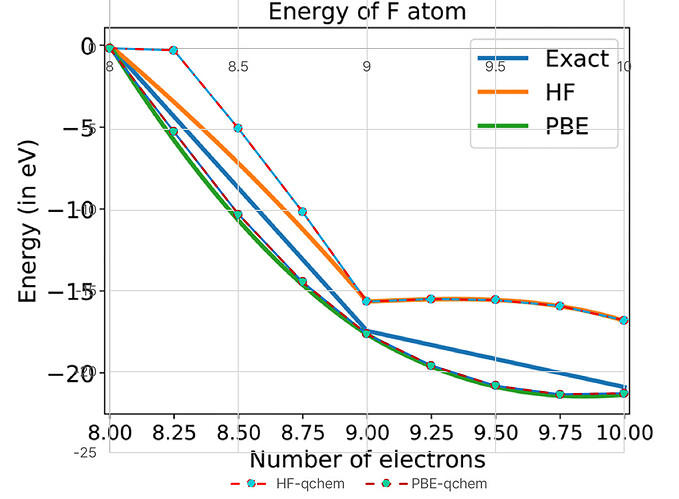Hi Qchem developers.
I am trying to reproduce the Figure 1A from the paper (https://doi.org/10.1021/acs.jpclett.8b02417),
which deals with the calculation of the fractional electron system (Fluoride).
I’ve managed to reproduce both HF and PBE for the region between the atom and the anion (9 to 10) using Qchem 6.0.
However, I couldn’t achieve the same results as in the literature for the region between the cation and the anion (8 to 9). They are always higher than the reference.
Are there any other parameters that I should consider in this case?
Thank you for your help.
-M
=== hf.in ===
$molecule
1 3
F 0.0000 0.0000 0.0000
$end
$rem
METHOD hf
SYM_IGNORE true
BASIS aug-pc-4
UNRESTRICTED true
$end
@@@
$molecule
0 2
F 0.0000 0.0000 0.0000
$end
$rem
METHOD hf
SYM_IGNORE true
FRACTIONAL_ELECTRON -750
BASIS aug-pc-4
UNRESTRICTED true
$end
@@@
$molecule
0 2
F 0.0000 0.0000 0.0000
$end
$rem
METHOD hf
SYM_IGNORE true
FRACTIONAL_ELECTRON -500
BASIS aug-pc-4
UNRESTRICTED true
$end
@@@
$molecule
0 2
F 0.0000 0.0000 0.0000
$end
$rem
METHOD hf
SYM_IGNORE true
FRACTIONAL_ELECTRON -250
BASIS aug-pc-4
UNRESTRICTED true
$end
@@@
$molecule
0 2
F 0.0000 0.0000 0.0000
$end
$rem
METHOD hf
SYM_IGNORE true
BASIS aug-pc-4
UNRESTRICTED true
$end
@@@
$molecule
-1 1
F 0.0000 0.0000 0.0000
$end
$rem
METHOD hf
SYM_IGNORE true
FRACTIONAL_ELECTRON -750
BASIS aug-pc-4
UNRESTRICTED true
$end
@@@
$molecule
-1 1
F 0.0000 0.0000 0.0000
$end
$rem
METHOD hf
SYM_IGNORE true
FRACTIONAL_ELECTRON -500
BASIS aug-pc-4
UNRESTRICTED true
$end
@@@
$molecule
-1 1
F 0.0000 0.0000 0.0000
$end
$rem
METHOD hf
SYM_IGNORE true
FRACTIONAL_ELECTRON -250
BASIS aug-pc-4
UNRESTRICTED true
$end
@@@
$molecule
-1 1
F 0.0000 0.0000 0.0000
$end
$rem
METHOD hf
SYM_IGNORE true
BASIS aug-pc-4
UNRESTRICTED true
$end
===$ grep ‘Total energy’ hf.out
Total energy in the final basis set = -98.8411025065
Total energy in the final basis set = -98.8459183660
Total energy in the final basis set = -99.0232568775
Total energy in the final basis set = -99.2127138721
Total energy in the final basis set = -99.4162407758
Total energy in the final basis set = -99.4108244623
Total energy in the final basis set = -99.4123898922
Total energy in the final basis set = -99.4264124734
Total energy in the final basis set = -99.4594088134
===pbe.in===
$molecule
1 3
F 0.0000 0.0000 0.0000
$end
$rem
METHOD pbe
SYM_IGNORE true
BASIS aug-pc-4
UNRESTRICTED true
$end
@@@
$molecule
0 2
F 0.0000 0.0000 0.0000
$end
$rem
METHOD pbe
SYM_IGNORE true
FRACTIONAL_ELECTRON -750
BASIS aug-pc-4
UNRESTRICTED true
$end
@@@
$molecule
0 2
F 0.0000 0.0000 0.0000
$end
$rem
METHOD pbe
SYM_IGNORE true
FRACTIONAL_ELECTRON -500
BASIS aug-pc-4
UNRESTRICTED true
$end
@@@
$molecule
0 2
F 0.0000 0.0000 0.0000
$end
$rem
METHOD pbe
SYM_IGNORE true
FRACTIONAL_ELECTRON -250
BASIS aug-pc-4
UNRESTRICTED true
$end
@@@
$molecule
0 2
F 0.0000 0.0000 0.0000
$end
$rem
METHOD pbe
SYM_IGNORE true
BASIS aug-pc-4
UNRESTRICTED true
$end
@@@
$molecule
-1 1
F 0.0000 0.0000 0.0000
$end
$rem
METHOD pbe
SYM_IGNORE true
FRACTIONAL_ELECTRON -750
BASIS aug-pc-4
UNRESTRICTED true
$end
@@@
$molecule
-1 1
F 0.0000 0.0000 0.0000
$end
$rem
METHOD pbe
SYM_IGNORE true
FRACTIONAL_ELECTRON -500
BASIS aug-pc-4
UNRESTRICTED true
$end
@@@
$molecule
-1 1
F 0.0000 0.0000 0.0000
$end
$rem
METHOD pbe
SYM_IGNORE true
FRACTIONAL_ELECTRON -250
BASIS aug-pc-4
UNRESTRICTED true
$end
@@@
$molecule
-1 1
F 0.0000 0.0000 0.0000
$end
$rem
METHOD pbe
SYM_IGNORE true
BASIS aug-pc-4
UNRESTRICTED true
$end
===$ grep ‘Total energy’ pbe.out
Total energy in the final basis set = -99.0272932281
Total energy in the final basis set = -99.2166570371
Total energy in the final basis set = -99.4049286299
Total energy in the final basis set = -99.5577450179
Total energy in the final basis set = -99.6760826908
Total energy in the final basis set = -99.7481371854
Total energy in the final basis set = -99.7935776923
Total energy in the final basis set = -99.8136566783
Total energy in the final basis set = -99.8110814542
